Strategic Operational Management
VerifiedAdded on 2023/04/21
|14
|4262
|423
AI Summary
This document discusses the key issues of strategy formulation and implementation in ANZ and Toyota. It explores the impact of decision-making in supply chain management and HRM on Toyota's strategic management practices. The document also analyzes Porter's Competitive Five Forces model and its application in P&G Ltd. It further discusses the application of Porter's Value Chain model in the contemporary business environment and its relevance to IKEA. Lastly, it evaluates the analysis and assessment phase of Samsung Company.
Contribute Materials
Your contribution can guide someone’s learning journey. Share your
documents today.
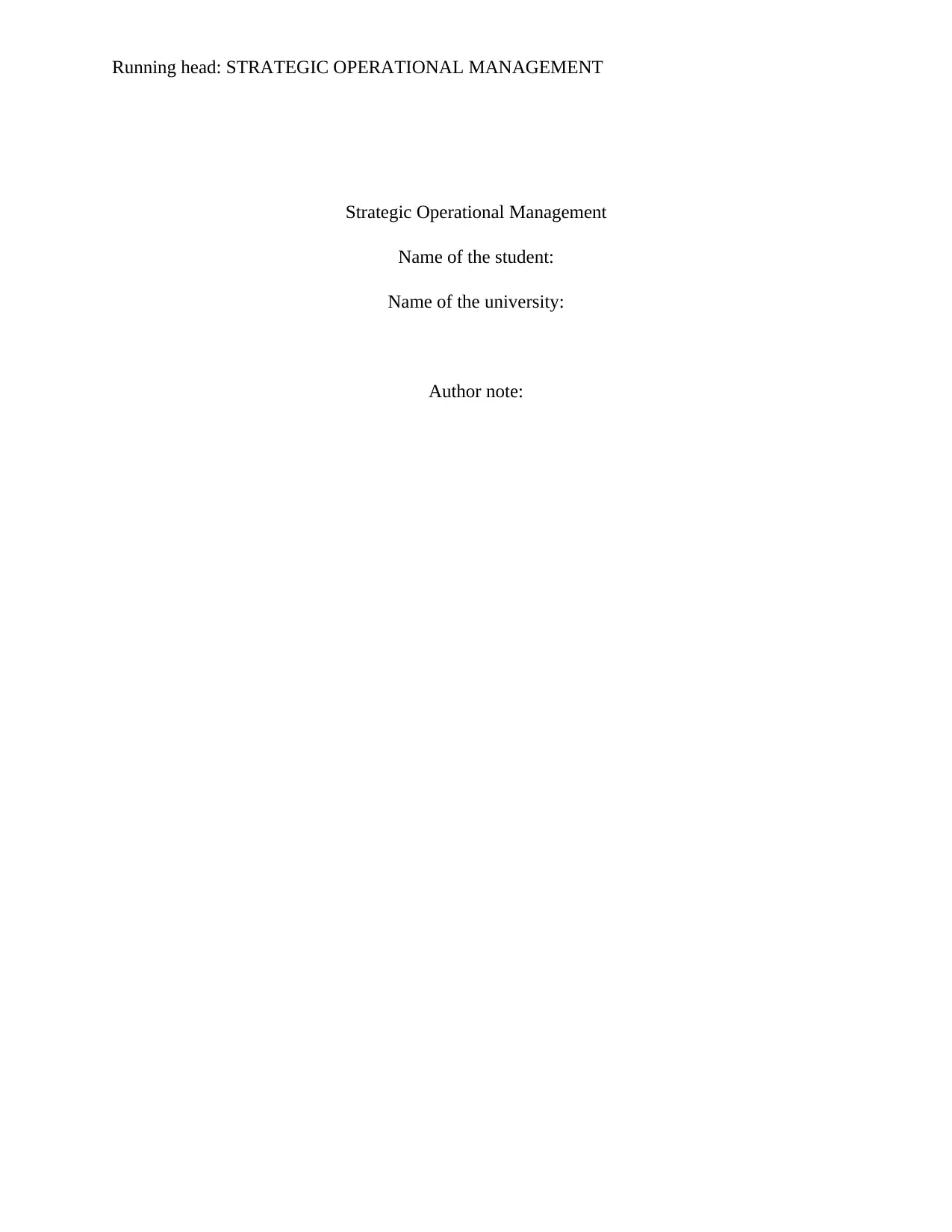
Running head: STRATEGIC OPERATIONAL MANAGEMENT
Strategic Operational Management
Name of the student:
Name of the university:
Author note:
Strategic Operational Management
Name of the student:
Name of the university:
Author note:
Secure Best Marks with AI Grader
Need help grading? Try our AI Grader for instant feedback on your assignments.

1STRATEGIC OPERATIONAL MANAGEMENT
Table of Contents
Question 1:.......................................................................................................................................2
Part A: Australia and New Zealand Banking Group Limited (ANZ)..........................................2
Key issues of ‘Strategy Formulation’ and ‘Strategy Implementation’....................................2
Evaluation................................................................................................................................2
Part B: Toyota, Japan...................................................................................................................3
Key issues of decision-making in regards to ‘Supply Chain Management’ and ‘Human
Resource Management & Job Design’....................................................................................3
Impact of these issues on the strategic management practices of Toyota, Japan....................4
Question 2:.......................................................................................................................................5
a) A critical analysis of Porter’s Competitive Five Forces model............................................5
b) Application of Porter’s Competitive Five Forces model in the contemporary operational
environment at P&G Ltd.............................................................................................................6
c) Application of Porters’ value chain model to contemporary business environment...............6
d) Application of Porter’s Value Chain model to IKEA as an approach they can use for
strategic management practice in their contemporary operational environment.........................7
Question 3: Samsung Smartphone...................................................................................................7
a) A critical evaluation of analysis and assessment phase of Samsung Company......................7
b) A critical evaluation of strategy formulation phase of Samsung Smartphone........................8
c) A critical evaluation of strategy implementation phase of Samsung Smartphone..................9
d) A critical evaluation of strategy evaluation phase of Samsung Smartphone........................10
References......................................................................................................................................11
Table of Contents
Question 1:.......................................................................................................................................2
Part A: Australia and New Zealand Banking Group Limited (ANZ)..........................................2
Key issues of ‘Strategy Formulation’ and ‘Strategy Implementation’....................................2
Evaluation................................................................................................................................2
Part B: Toyota, Japan...................................................................................................................3
Key issues of decision-making in regards to ‘Supply Chain Management’ and ‘Human
Resource Management & Job Design’....................................................................................3
Impact of these issues on the strategic management practices of Toyota, Japan....................4
Question 2:.......................................................................................................................................5
a) A critical analysis of Porter’s Competitive Five Forces model............................................5
b) Application of Porter’s Competitive Five Forces model in the contemporary operational
environment at P&G Ltd.............................................................................................................6
c) Application of Porters’ value chain model to contemporary business environment...............6
d) Application of Porter’s Value Chain model to IKEA as an approach they can use for
strategic management practice in their contemporary operational environment.........................7
Question 3: Samsung Smartphone...................................................................................................7
a) A critical evaluation of analysis and assessment phase of Samsung Company......................7
b) A critical evaluation of strategy formulation phase of Samsung Smartphone........................8
c) A critical evaluation of strategy implementation phase of Samsung Smartphone..................9
d) A critical evaluation of strategy evaluation phase of Samsung Smartphone........................10
References......................................................................................................................................11
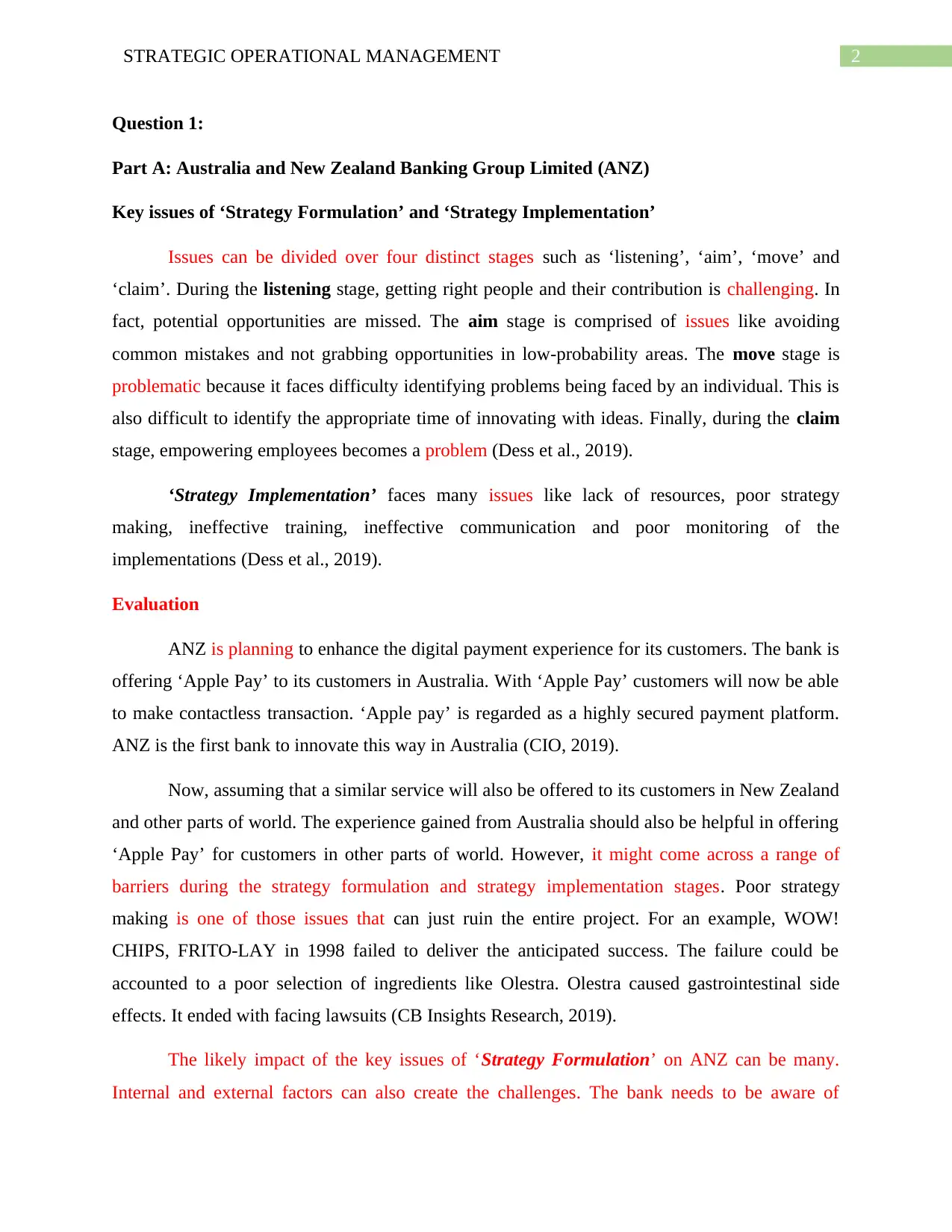
2STRATEGIC OPERATIONAL MANAGEMENT
Question 1:
Part A: Australia and New Zealand Banking Group Limited (ANZ)
Key issues of ‘Strategy Formulation’ and ‘Strategy Implementation’
Issues can be divided over four distinct stages such as ‘listening’, ‘aim’, ‘move’ and
‘claim’. During the listening stage, getting right people and their contribution is challenging. In
fact, potential opportunities are missed. The aim stage is comprised of issues like avoiding
common mistakes and not grabbing opportunities in low-probability areas. The move stage is
problematic because it faces difficulty identifying problems being faced by an individual. This is
also difficult to identify the appropriate time of innovating with ideas. Finally, during the claim
stage, empowering employees becomes a problem (Dess et al., 2019).
‘Strategy Implementation’ faces many issues like lack of resources, poor strategy
making, ineffective training, ineffective communication and poor monitoring of the
implementations (Dess et al., 2019).
Evaluation
ANZ is planning to enhance the digital payment experience for its customers. The bank is
offering ‘Apple Pay’ to its customers in Australia. With ‘Apple Pay’ customers will now be able
to make contactless transaction. ‘Apple pay’ is regarded as a highly secured payment platform.
ANZ is the first bank to innovate this way in Australia (CIO, 2019).
Now, assuming that a similar service will also be offered to its customers in New Zealand
and other parts of world. The experience gained from Australia should also be helpful in offering
‘Apple Pay’ for customers in other parts of world. However, it might come across a range of
barriers during the strategy formulation and strategy implementation stages. Poor strategy
making is one of those issues that can just ruin the entire project. For an example, WOW!
CHIPS, FRITO-LAY in 1998 failed to deliver the anticipated success. The failure could be
accounted to a poor selection of ingredients like Olestra. Olestra caused gastrointestinal side
effects. It ended with facing lawsuits (CB Insights Research, 2019).
The likely impact of the key issues of ‘Strategy Formulation’ on ANZ can be many.
Internal and external factors can also create the challenges. The bank needs to be aware of
Question 1:
Part A: Australia and New Zealand Banking Group Limited (ANZ)
Key issues of ‘Strategy Formulation’ and ‘Strategy Implementation’
Issues can be divided over four distinct stages such as ‘listening’, ‘aim’, ‘move’ and
‘claim’. During the listening stage, getting right people and their contribution is challenging. In
fact, potential opportunities are missed. The aim stage is comprised of issues like avoiding
common mistakes and not grabbing opportunities in low-probability areas. The move stage is
problematic because it faces difficulty identifying problems being faced by an individual. This is
also difficult to identify the appropriate time of innovating with ideas. Finally, during the claim
stage, empowering employees becomes a problem (Dess et al., 2019).
‘Strategy Implementation’ faces many issues like lack of resources, poor strategy
making, ineffective training, ineffective communication and poor monitoring of the
implementations (Dess et al., 2019).
Evaluation
ANZ is planning to enhance the digital payment experience for its customers. The bank is
offering ‘Apple Pay’ to its customers in Australia. With ‘Apple Pay’ customers will now be able
to make contactless transaction. ‘Apple pay’ is regarded as a highly secured payment platform.
ANZ is the first bank to innovate this way in Australia (CIO, 2019).
Now, assuming that a similar service will also be offered to its customers in New Zealand
and other parts of world. The experience gained from Australia should also be helpful in offering
‘Apple Pay’ for customers in other parts of world. However, it might come across a range of
barriers during the strategy formulation and strategy implementation stages. Poor strategy
making is one of those issues that can just ruin the entire project. For an example, WOW!
CHIPS, FRITO-LAY in 1998 failed to deliver the anticipated success. The failure could be
accounted to a poor selection of ingredients like Olestra. Olestra caused gastrointestinal side
effects. It ended with facing lawsuits (CB Insights Research, 2019).
The likely impact of the key issues of ‘Strategy Formulation’ on ANZ can be many.
Internal and external factors can also create the challenges. The bank needs to be aware of
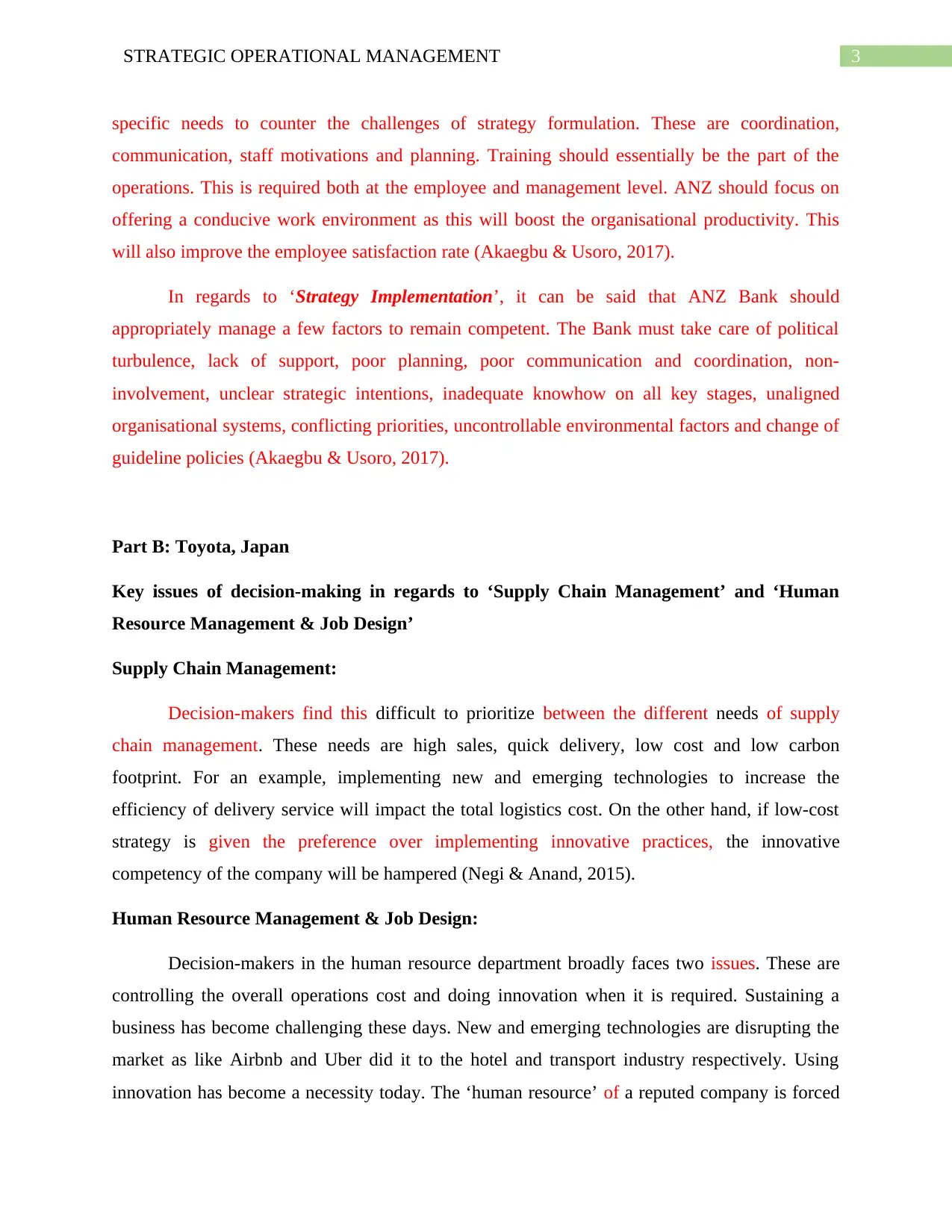
3STRATEGIC OPERATIONAL MANAGEMENT
specific needs to counter the challenges of strategy formulation. These are coordination,
communication, staff motivations and planning. Training should essentially be the part of the
operations. This is required both at the employee and management level. ANZ should focus on
offering a conducive work environment as this will boost the organisational productivity. This
will also improve the employee satisfaction rate (Akaegbu & Usoro, 2017).
In regards to ‘Strategy Implementation’, it can be said that ANZ Bank should
appropriately manage a few factors to remain competent. The Bank must take care of political
turbulence, lack of support, poor planning, poor communication and coordination, non-
involvement, unclear strategic intentions, inadequate knowhow on all key stages, unaligned
organisational systems, conflicting priorities, uncontrollable environmental factors and change of
guideline policies (Akaegbu & Usoro, 2017).
Part B: Toyota, Japan
Key issues of decision-making in regards to ‘Supply Chain Management’ and ‘Human
Resource Management & Job Design’
Supply Chain Management:
Decision-makers find this difficult to prioritize between the different needs of supply
chain management. These needs are high sales, quick delivery, low cost and low carbon
footprint. For an example, implementing new and emerging technologies to increase the
efficiency of delivery service will impact the total logistics cost. On the other hand, if low-cost
strategy is given the preference over implementing innovative practices, the innovative
competency of the company will be hampered (Negi & Anand, 2015).
Human Resource Management & Job Design:
Decision-makers in the human resource department broadly faces two issues. These are
controlling the overall operations cost and doing innovation when it is required. Sustaining a
business has become challenging these days. New and emerging technologies are disrupting the
market as like Airbnb and Uber did it to the hotel and transport industry respectively. Using
innovation has become a necessity today. The ‘human resource’ of a reputed company is forced
specific needs to counter the challenges of strategy formulation. These are coordination,
communication, staff motivations and planning. Training should essentially be the part of the
operations. This is required both at the employee and management level. ANZ should focus on
offering a conducive work environment as this will boost the organisational productivity. This
will also improve the employee satisfaction rate (Akaegbu & Usoro, 2017).
In regards to ‘Strategy Implementation’, it can be said that ANZ Bank should
appropriately manage a few factors to remain competent. The Bank must take care of political
turbulence, lack of support, poor planning, poor communication and coordination, non-
involvement, unclear strategic intentions, inadequate knowhow on all key stages, unaligned
organisational systems, conflicting priorities, uncontrollable environmental factors and change of
guideline policies (Akaegbu & Usoro, 2017).
Part B: Toyota, Japan
Key issues of decision-making in regards to ‘Supply Chain Management’ and ‘Human
Resource Management & Job Design’
Supply Chain Management:
Decision-makers find this difficult to prioritize between the different needs of supply
chain management. These needs are high sales, quick delivery, low cost and low carbon
footprint. For an example, implementing new and emerging technologies to increase the
efficiency of delivery service will impact the total logistics cost. On the other hand, if low-cost
strategy is given the preference over implementing innovative practices, the innovative
competency of the company will be hampered (Negi & Anand, 2015).
Human Resource Management & Job Design:
Decision-makers in the human resource department broadly faces two issues. These are
controlling the overall operations cost and doing innovation when it is required. Sustaining a
business has become challenging these days. New and emerging technologies are disrupting the
market as like Airbnb and Uber did it to the hotel and transport industry respectively. Using
innovation has become a necessity today. The ‘human resource’ of a reputed company is forced
Secure Best Marks with AI Grader
Need help grading? Try our AI Grader for instant feedback on your assignments.
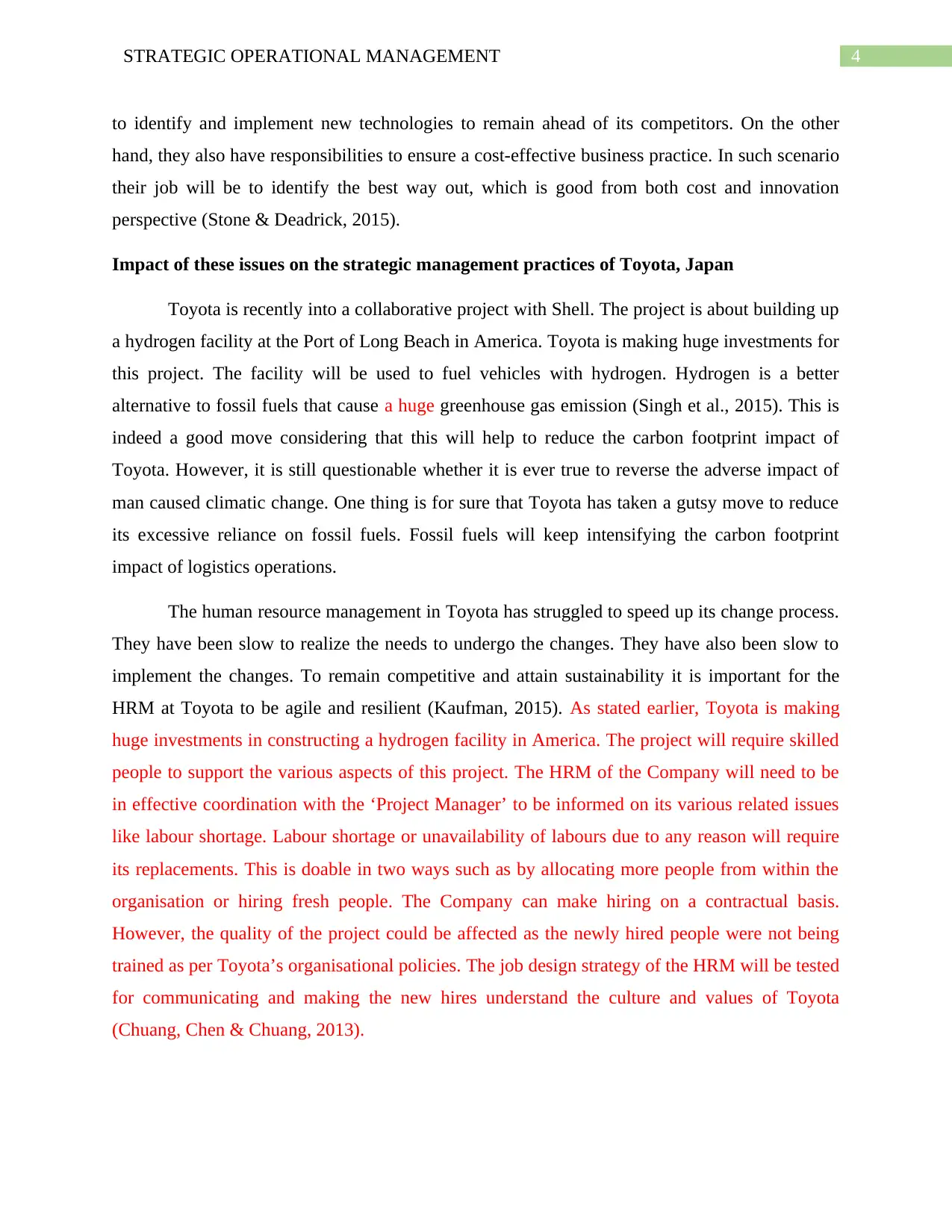
4STRATEGIC OPERATIONAL MANAGEMENT
to identify and implement new technologies to remain ahead of its competitors. On the other
hand, they also have responsibilities to ensure a cost-effective business practice. In such scenario
their job will be to identify the best way out, which is good from both cost and innovation
perspective (Stone & Deadrick, 2015).
Impact of these issues on the strategic management practices of Toyota, Japan
Toyota is recently into a collaborative project with Shell. The project is about building up
a hydrogen facility at the Port of Long Beach in America. Toyota is making huge investments for
this project. The facility will be used to fuel vehicles with hydrogen. Hydrogen is a better
alternative to fossil fuels that cause a huge greenhouse gas emission (Singh et al., 2015). This is
indeed a good move considering that this will help to reduce the carbon footprint impact of
Toyota. However, it is still questionable whether it is ever true to reverse the adverse impact of
man caused climatic change. One thing is for sure that Toyota has taken a gutsy move to reduce
its excessive reliance on fossil fuels. Fossil fuels will keep intensifying the carbon footprint
impact of logistics operations.
The human resource management in Toyota has struggled to speed up its change process.
They have been slow to realize the needs to undergo the changes. They have also been slow to
implement the changes. To remain competitive and attain sustainability it is important for the
HRM at Toyota to be agile and resilient (Kaufman, 2015). As stated earlier, Toyota is making
huge investments in constructing a hydrogen facility in America. The project will require skilled
people to support the various aspects of this project. The HRM of the Company will need to be
in effective coordination with the ‘Project Manager’ to be informed on its various related issues
like labour shortage. Labour shortage or unavailability of labours due to any reason will require
its replacements. This is doable in two ways such as by allocating more people from within the
organisation or hiring fresh people. The Company can make hiring on a contractual basis.
However, the quality of the project could be affected as the newly hired people were not being
trained as per Toyota’s organisational policies. The job design strategy of the HRM will be tested
for communicating and making the new hires understand the culture and values of Toyota
(Chuang, Chen & Chuang, 2013).
to identify and implement new technologies to remain ahead of its competitors. On the other
hand, they also have responsibilities to ensure a cost-effective business practice. In such scenario
their job will be to identify the best way out, which is good from both cost and innovation
perspective (Stone & Deadrick, 2015).
Impact of these issues on the strategic management practices of Toyota, Japan
Toyota is recently into a collaborative project with Shell. The project is about building up
a hydrogen facility at the Port of Long Beach in America. Toyota is making huge investments for
this project. The facility will be used to fuel vehicles with hydrogen. Hydrogen is a better
alternative to fossil fuels that cause a huge greenhouse gas emission (Singh et al., 2015). This is
indeed a good move considering that this will help to reduce the carbon footprint impact of
Toyota. However, it is still questionable whether it is ever true to reverse the adverse impact of
man caused climatic change. One thing is for sure that Toyota has taken a gutsy move to reduce
its excessive reliance on fossil fuels. Fossil fuels will keep intensifying the carbon footprint
impact of logistics operations.
The human resource management in Toyota has struggled to speed up its change process.
They have been slow to realize the needs to undergo the changes. They have also been slow to
implement the changes. To remain competitive and attain sustainability it is important for the
HRM at Toyota to be agile and resilient (Kaufman, 2015). As stated earlier, Toyota is making
huge investments in constructing a hydrogen facility in America. The project will require skilled
people to support the various aspects of this project. The HRM of the Company will need to be
in effective coordination with the ‘Project Manager’ to be informed on its various related issues
like labour shortage. Labour shortage or unavailability of labours due to any reason will require
its replacements. This is doable in two ways such as by allocating more people from within the
organisation or hiring fresh people. The Company can make hiring on a contractual basis.
However, the quality of the project could be affected as the newly hired people were not being
trained as per Toyota’s organisational policies. The job design strategy of the HRM will be tested
for communicating and making the new hires understand the culture and values of Toyota
(Chuang, Chen & Chuang, 2013).
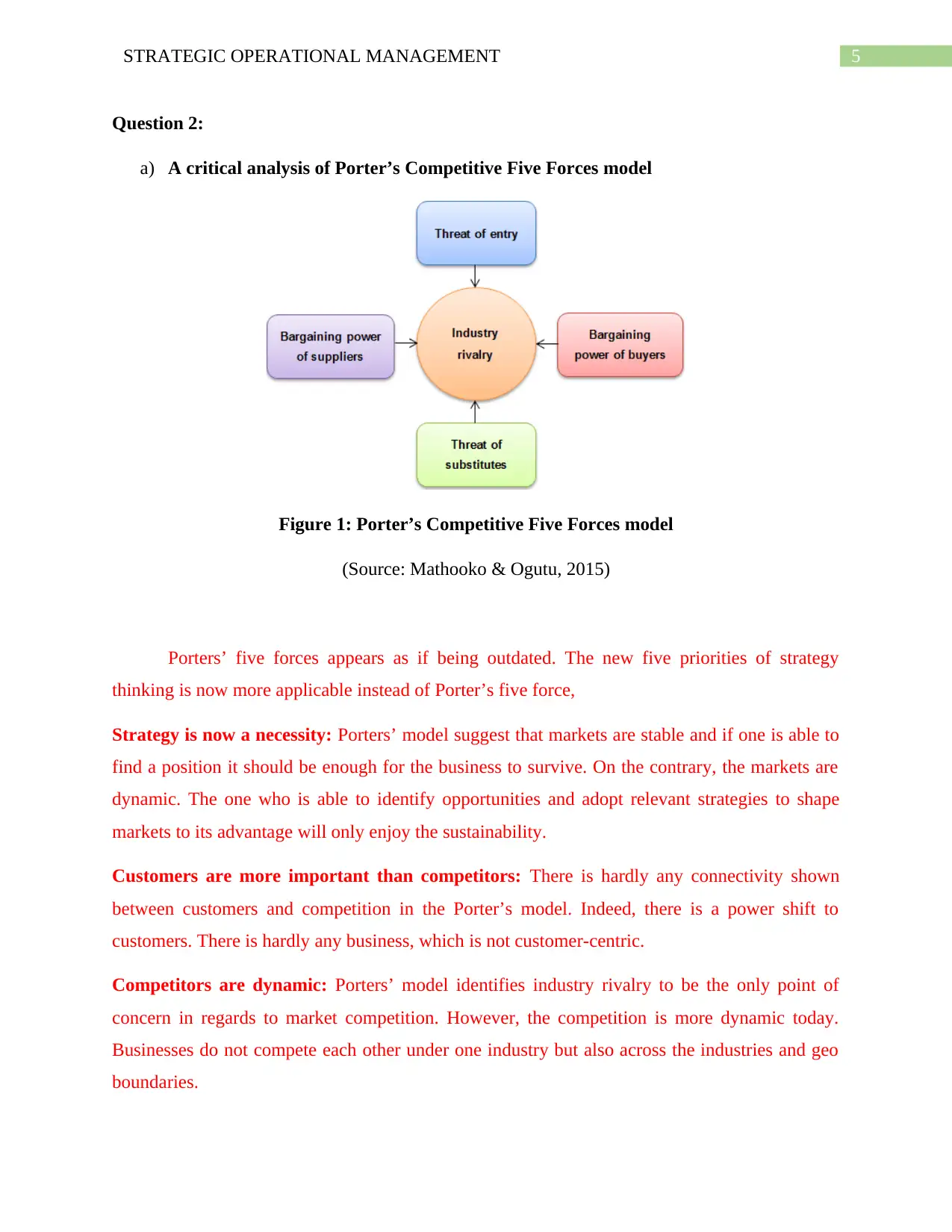
5STRATEGIC OPERATIONAL MANAGEMENT
Question 2:
a) A critical analysis of Porter’s Competitive Five Forces model
Figure 1: Porter’s Competitive Five Forces model
(Source: Mathooko & Ogutu, 2015)
Porters’ five forces appears as if being outdated. The new five priorities of strategy
thinking is now more applicable instead of Porter’s five force,
Strategy is now a necessity: Porters’ model suggest that markets are stable and if one is able to
find a position it should be enough for the business to survive. On the contrary, the markets are
dynamic. The one who is able to identify opportunities and adopt relevant strategies to shape
markets to its advantage will only enjoy the sustainability.
Customers are more important than competitors: There is hardly any connectivity shown
between customers and competition in the Porter’s model. Indeed, there is a power shift to
customers. There is hardly any business, which is not customer-centric.
Competitors are dynamic: Porters’ model identifies industry rivalry to be the only point of
concern in regards to market competition. However, the competition is more dynamic today.
Businesses do not compete each other under one industry but also across the industries and geo
boundaries.
Question 2:
a) A critical analysis of Porter’s Competitive Five Forces model
Figure 1: Porter’s Competitive Five Forces model
(Source: Mathooko & Ogutu, 2015)
Porters’ five forces appears as if being outdated. The new five priorities of strategy
thinking is now more applicable instead of Porter’s five force,
Strategy is now a necessity: Porters’ model suggest that markets are stable and if one is able to
find a position it should be enough for the business to survive. On the contrary, the markets are
dynamic. The one who is able to identify opportunities and adopt relevant strategies to shape
markets to its advantage will only enjoy the sustainability.
Customers are more important than competitors: There is hardly any connectivity shown
between customers and competition in the Porter’s model. Indeed, there is a power shift to
customers. There is hardly any business, which is not customer-centric.
Competitors are dynamic: Porters’ model identifies industry rivalry to be the only point of
concern in regards to market competition. However, the competition is more dynamic today.
Businesses do not compete each other under one industry but also across the industries and geo
boundaries.
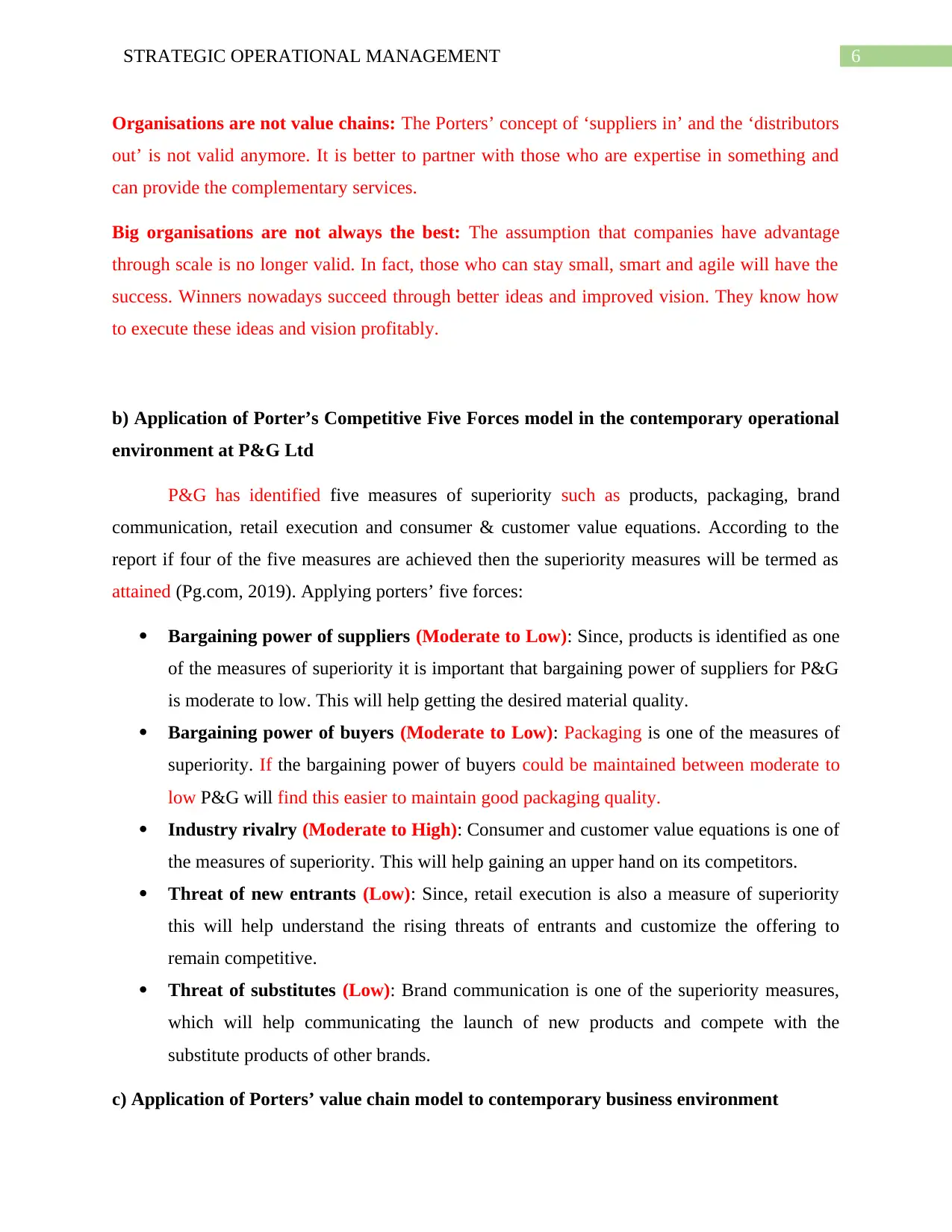
6STRATEGIC OPERATIONAL MANAGEMENT
Organisations are not value chains: The Porters’ concept of ‘suppliers in’ and the ‘distributors
out’ is not valid anymore. It is better to partner with those who are expertise in something and
can provide the complementary services.
Big organisations are not always the best: The assumption that companies have advantage
through scale is no longer valid. In fact, those who can stay small, smart and agile will have the
success. Winners nowadays succeed through better ideas and improved vision. They know how
to execute these ideas and vision profitably.
b) Application of Porter’s Competitive Five Forces model in the contemporary operational
environment at P&G Ltd
P&G has identified five measures of superiority such as products, packaging, brand
communication, retail execution and consumer & customer value equations. According to the
report if four of the five measures are achieved then the superiority measures will be termed as
attained (Pg.com, 2019). Applying porters’ five forces:
Bargaining power of suppliers (Moderate to Low): Since, products is identified as one
of the measures of superiority it is important that bargaining power of suppliers for P&G
is moderate to low. This will help getting the desired material quality.
Bargaining power of buyers (Moderate to Low): Packaging is one of the measures of
superiority. If the bargaining power of buyers could be maintained between moderate to
low P&G will find this easier to maintain good packaging quality.
Industry rivalry (Moderate to High): Consumer and customer value equations is one of
the measures of superiority. This will help gaining an upper hand on its competitors.
Threat of new entrants (Low): Since, retail execution is also a measure of superiority
this will help understand the rising threats of entrants and customize the offering to
remain competitive.
Threat of substitutes (Low): Brand communication is one of the superiority measures,
which will help communicating the launch of new products and compete with the
substitute products of other brands.
c) Application of Porters’ value chain model to contemporary business environment
Organisations are not value chains: The Porters’ concept of ‘suppliers in’ and the ‘distributors
out’ is not valid anymore. It is better to partner with those who are expertise in something and
can provide the complementary services.
Big organisations are not always the best: The assumption that companies have advantage
through scale is no longer valid. In fact, those who can stay small, smart and agile will have the
success. Winners nowadays succeed through better ideas and improved vision. They know how
to execute these ideas and vision profitably.
b) Application of Porter’s Competitive Five Forces model in the contemporary operational
environment at P&G Ltd
P&G has identified five measures of superiority such as products, packaging, brand
communication, retail execution and consumer & customer value equations. According to the
report if four of the five measures are achieved then the superiority measures will be termed as
attained (Pg.com, 2019). Applying porters’ five forces:
Bargaining power of suppliers (Moderate to Low): Since, products is identified as one
of the measures of superiority it is important that bargaining power of suppliers for P&G
is moderate to low. This will help getting the desired material quality.
Bargaining power of buyers (Moderate to Low): Packaging is one of the measures of
superiority. If the bargaining power of buyers could be maintained between moderate to
low P&G will find this easier to maintain good packaging quality.
Industry rivalry (Moderate to High): Consumer and customer value equations is one of
the measures of superiority. This will help gaining an upper hand on its competitors.
Threat of new entrants (Low): Since, retail execution is also a measure of superiority
this will help understand the rising threats of entrants and customize the offering to
remain competitive.
Threat of substitutes (Low): Brand communication is one of the superiority measures,
which will help communicating the launch of new products and compete with the
substitute products of other brands.
c) Application of Porters’ value chain model to contemporary business environment
Paraphrase This Document
Need a fresh take? Get an instant paraphrase of this document with our AI Paraphraser
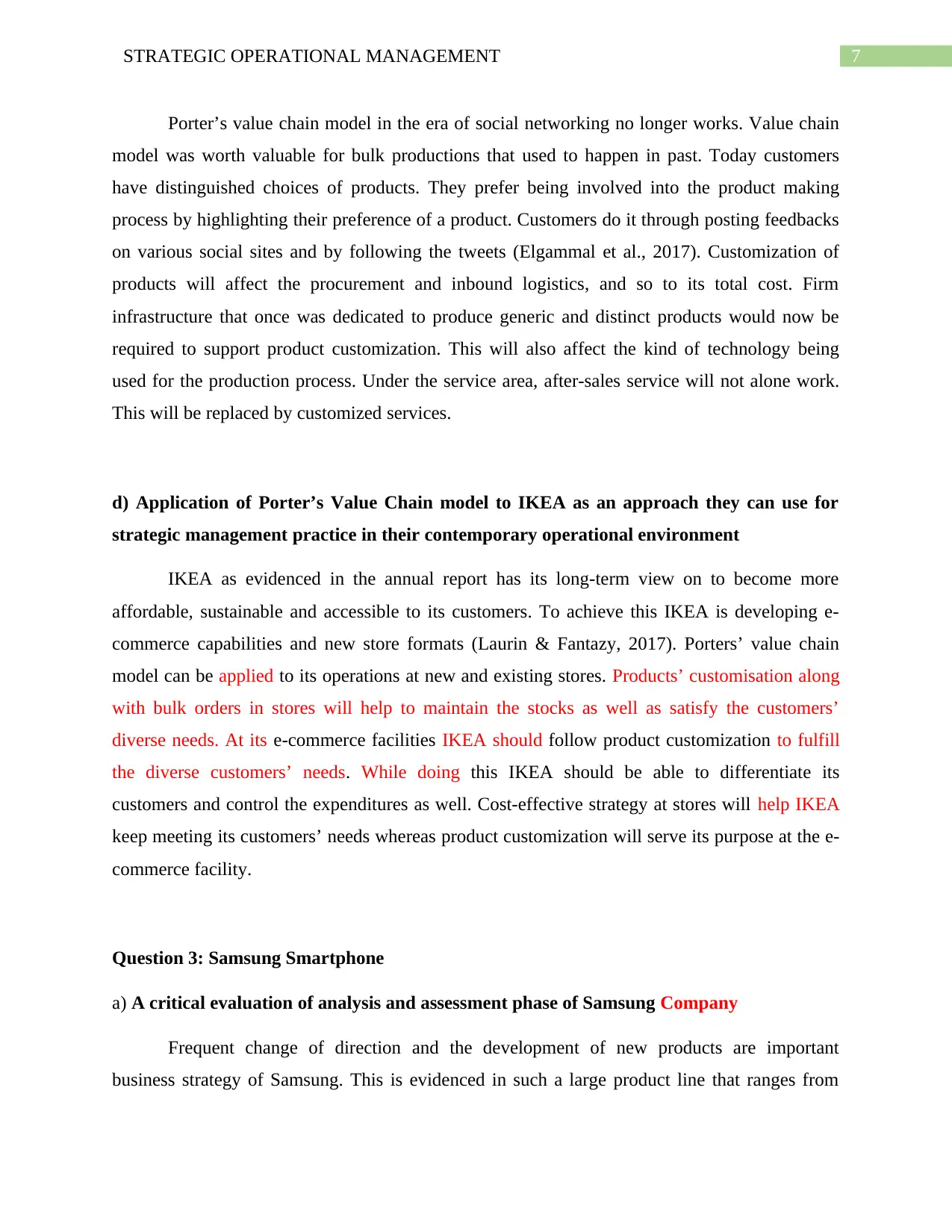
7STRATEGIC OPERATIONAL MANAGEMENT
Porter’s value chain model in the era of social networking no longer works. Value chain
model was worth valuable for bulk productions that used to happen in past. Today customers
have distinguished choices of products. They prefer being involved into the product making
process by highlighting their preference of a product. Customers do it through posting feedbacks
on various social sites and by following the tweets (Elgammal et al., 2017). Customization of
products will affect the procurement and inbound logistics, and so to its total cost. Firm
infrastructure that once was dedicated to produce generic and distinct products would now be
required to support product customization. This will also affect the kind of technology being
used for the production process. Under the service area, after-sales service will not alone work.
This will be replaced by customized services.
d) Application of Porter’s Value Chain model to IKEA as an approach they can use for
strategic management practice in their contemporary operational environment
IKEA as evidenced in the annual report has its long-term view on to become more
affordable, sustainable and accessible to its customers. To achieve this IKEA is developing e-
commerce capabilities and new store formats (Laurin & Fantazy, 2017). Porters’ value chain
model can be applied to its operations at new and existing stores. Products’ customisation along
with bulk orders in stores will help to maintain the stocks as well as satisfy the customers’
diverse needs. At its e-commerce facilities IKEA should follow product customization to fulfill
the diverse customers’ needs. While doing this IKEA should be able to differentiate its
customers and control the expenditures as well. Cost-effective strategy at stores will help IKEA
keep meeting its customers’ needs whereas product customization will serve its purpose at the e-
commerce facility.
Question 3: Samsung Smartphone
a) A critical evaluation of analysis and assessment phase of Samsung Company
Frequent change of direction and the development of new products are important
business strategy of Samsung. This is evidenced in such a large product line that ranges from
Porter’s value chain model in the era of social networking no longer works. Value chain
model was worth valuable for bulk productions that used to happen in past. Today customers
have distinguished choices of products. They prefer being involved into the product making
process by highlighting their preference of a product. Customers do it through posting feedbacks
on various social sites and by following the tweets (Elgammal et al., 2017). Customization of
products will affect the procurement and inbound logistics, and so to its total cost. Firm
infrastructure that once was dedicated to produce generic and distinct products would now be
required to support product customization. This will also affect the kind of technology being
used for the production process. Under the service area, after-sales service will not alone work.
This will be replaced by customized services.
d) Application of Porter’s Value Chain model to IKEA as an approach they can use for
strategic management practice in their contemporary operational environment
IKEA as evidenced in the annual report has its long-term view on to become more
affordable, sustainable and accessible to its customers. To achieve this IKEA is developing e-
commerce capabilities and new store formats (Laurin & Fantazy, 2017). Porters’ value chain
model can be applied to its operations at new and existing stores. Products’ customisation along
with bulk orders in stores will help to maintain the stocks as well as satisfy the customers’
diverse needs. At its e-commerce facilities IKEA should follow product customization to fulfill
the diverse customers’ needs. While doing this IKEA should be able to differentiate its
customers and control the expenditures as well. Cost-effective strategy at stores will help IKEA
keep meeting its customers’ needs whereas product customization will serve its purpose at the e-
commerce facility.
Question 3: Samsung Smartphone
a) A critical evaluation of analysis and assessment phase of Samsung Company
Frequent change of direction and the development of new products are important
business strategy of Samsung. This is evidenced in such a large product line that ranges from
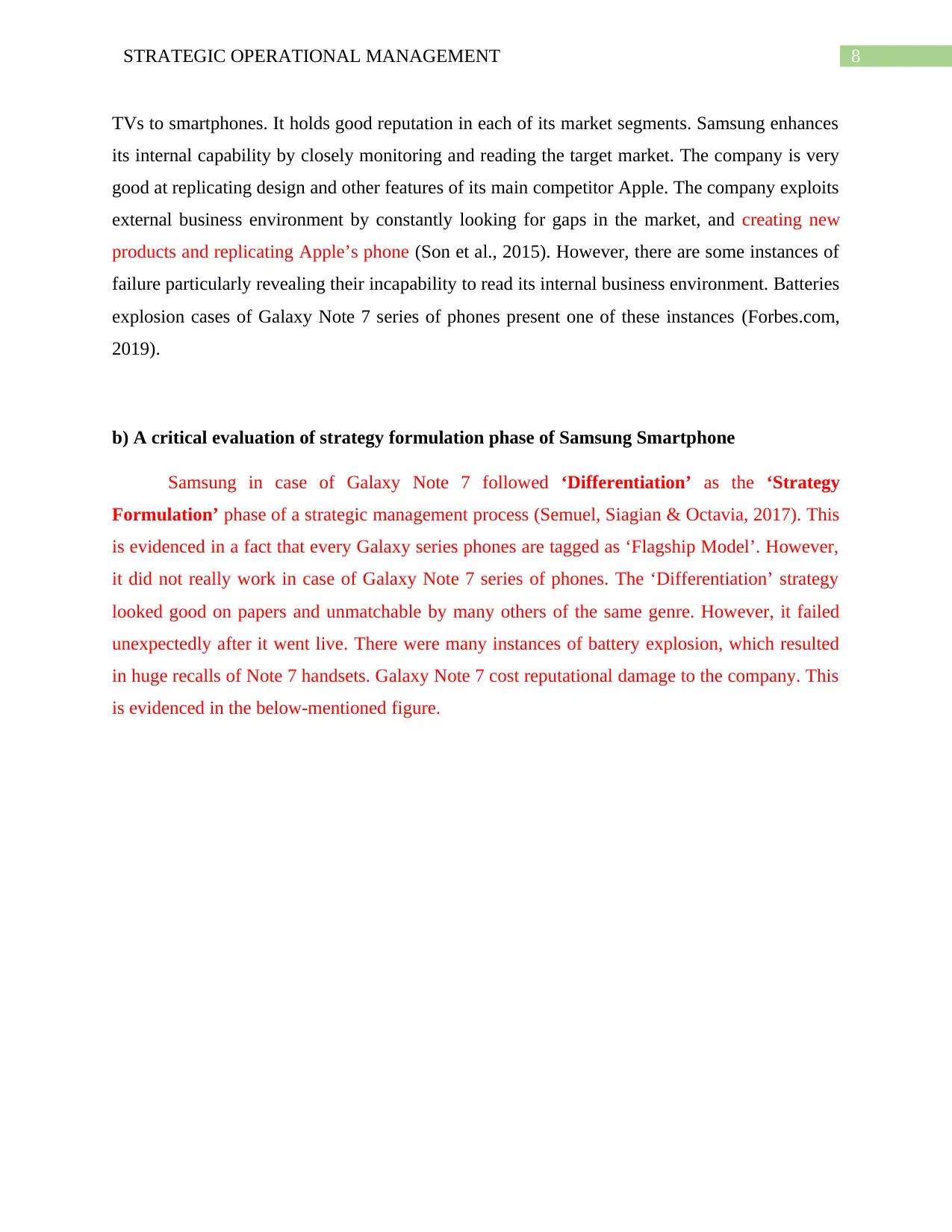
8STRATEGIC OPERATIONAL MANAGEMENT
TVs to smartphones. It holds good reputation in each of its market segments. Samsung enhances
its internal capability by closely monitoring and reading the target market. The company is very
good at replicating design and other features of its main competitor Apple. The company exploits
external business environment by constantly looking for gaps in the market, and creating new
products and replicating Apple’s phone (Son et al., 2015). However, there are some instances of
failure particularly revealing their incapability to read its internal business environment. Batteries
explosion cases of Galaxy Note 7 series of phones present one of these instances (Forbes.com,
2019).
b) A critical evaluation of strategy formulation phase of Samsung Smartphone
Samsung in case of Galaxy Note 7 followed ‘Differentiation’ as the ‘Strategy
Formulation’ phase of a strategic management process (Semuel, Siagian & Octavia, 2017). This
is evidenced in a fact that every Galaxy series phones are tagged as ‘Flagship Model’. However,
it did not really work in case of Galaxy Note 7 series of phones. The ‘Differentiation’ strategy
looked good on papers and unmatchable by many others of the same genre. However, it failed
unexpectedly after it went live. There were many instances of battery explosion, which resulted
in huge recalls of Note 7 handsets. Galaxy Note 7 cost reputational damage to the company. This
is evidenced in the below-mentioned figure.
TVs to smartphones. It holds good reputation in each of its market segments. Samsung enhances
its internal capability by closely monitoring and reading the target market. The company is very
good at replicating design and other features of its main competitor Apple. The company exploits
external business environment by constantly looking for gaps in the market, and creating new
products and replicating Apple’s phone (Son et al., 2015). However, there are some instances of
failure particularly revealing their incapability to read its internal business environment. Batteries
explosion cases of Galaxy Note 7 series of phones present one of these instances (Forbes.com,
2019).
b) A critical evaluation of strategy formulation phase of Samsung Smartphone
Samsung in case of Galaxy Note 7 followed ‘Differentiation’ as the ‘Strategy
Formulation’ phase of a strategic management process (Semuel, Siagian & Octavia, 2017). This
is evidenced in a fact that every Galaxy series phones are tagged as ‘Flagship Model’. However,
it did not really work in case of Galaxy Note 7 series of phones. The ‘Differentiation’ strategy
looked good on papers and unmatchable by many others of the same genre. However, it failed
unexpectedly after it went live. There were many instances of battery explosion, which resulted
in huge recalls of Note 7 handsets. Galaxy Note 7 cost reputational damage to the company. This
is evidenced in the below-mentioned figure.
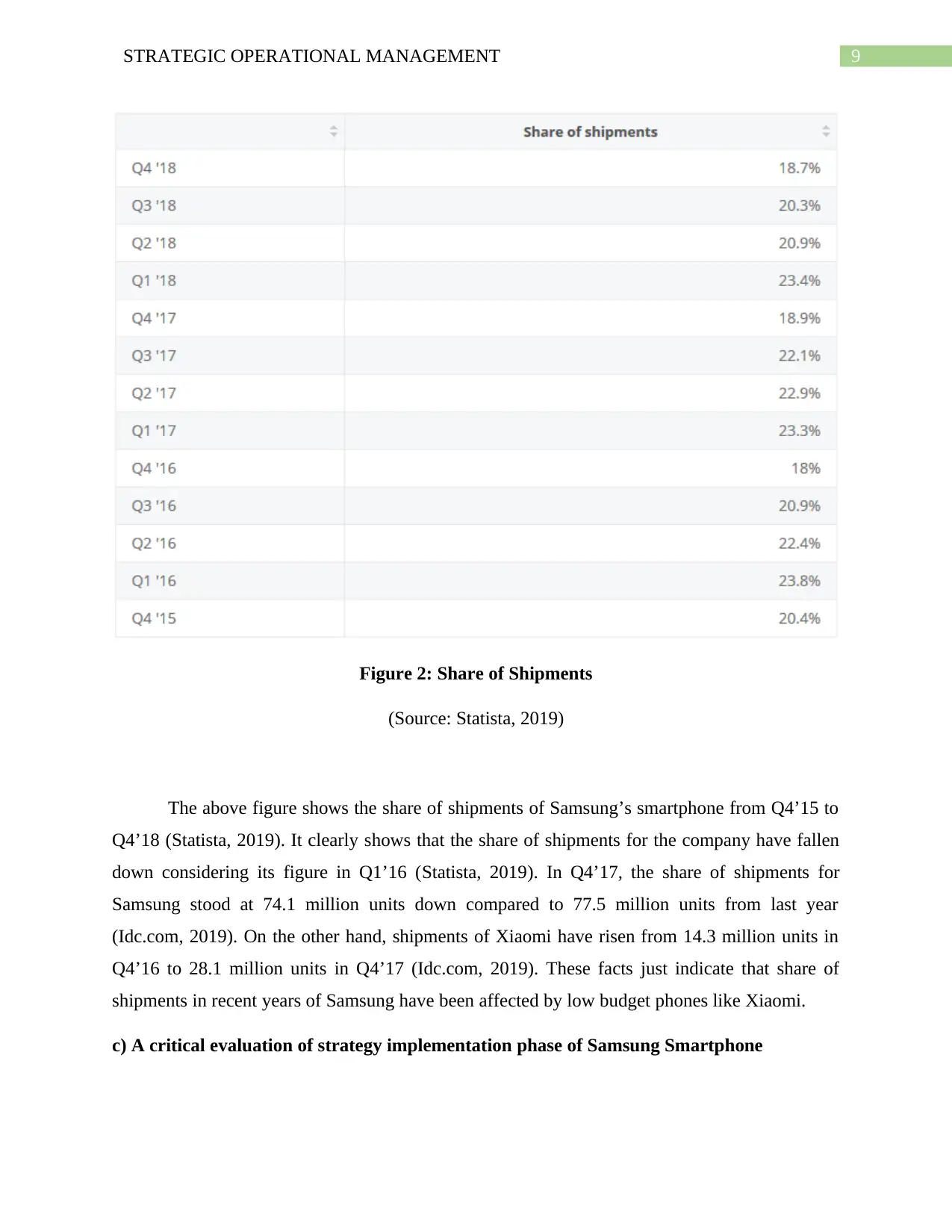
9STRATEGIC OPERATIONAL MANAGEMENT
Figure 2: Share of Shipments
(Source: Statista, 2019)
The above figure shows the share of shipments of Samsung’s smartphone from Q4’15 to
Q4’18 (Statista, 2019). It clearly shows that the share of shipments for the company have fallen
down considering its figure in Q1’16 (Statista, 2019). In Q4’17, the share of shipments for
Samsung stood at 74.1 million units down compared to 77.5 million units from last year
(Idc.com, 2019). On the other hand, shipments of Xiaomi have risen from 14.3 million units in
Q4’16 to 28.1 million units in Q4’17 (Idc.com, 2019). These facts just indicate that share of
shipments in recent years of Samsung have been affected by low budget phones like Xiaomi.
c) A critical evaluation of strategy implementation phase of Samsung Smartphone
Figure 2: Share of Shipments
(Source: Statista, 2019)
The above figure shows the share of shipments of Samsung’s smartphone from Q4’15 to
Q4’18 (Statista, 2019). It clearly shows that the share of shipments for the company have fallen
down considering its figure in Q1’16 (Statista, 2019). In Q4’17, the share of shipments for
Samsung stood at 74.1 million units down compared to 77.5 million units from last year
(Idc.com, 2019). On the other hand, shipments of Xiaomi have risen from 14.3 million units in
Q4’16 to 28.1 million units in Q4’17 (Idc.com, 2019). These facts just indicate that share of
shipments in recent years of Samsung have been affected by low budget phones like Xiaomi.
c) A critical evaluation of strategy implementation phase of Samsung Smartphone
Secure Best Marks with AI Grader
Need help grading? Try our AI Grader for instant feedback on your assignments.
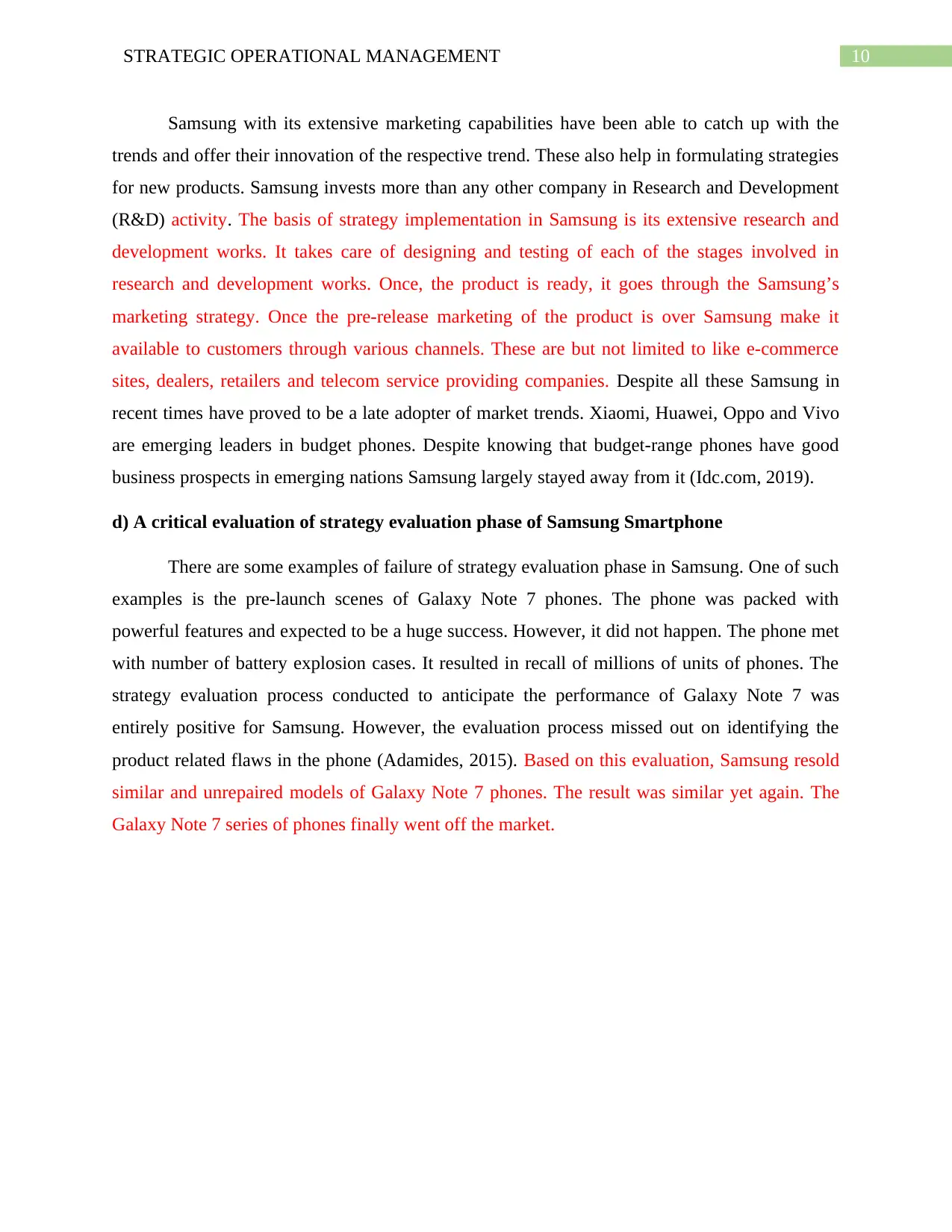
10STRATEGIC OPERATIONAL MANAGEMENT
Samsung with its extensive marketing capabilities have been able to catch up with the
trends and offer their innovation of the respective trend. These also help in formulating strategies
for new products. Samsung invests more than any other company in Research and Development
(R&D) activity. The basis of strategy implementation in Samsung is its extensive research and
development works. It takes care of designing and testing of each of the stages involved in
research and development works. Once, the product is ready, it goes through the Samsung’s
marketing strategy. Once the pre-release marketing of the product is over Samsung make it
available to customers through various channels. These are but not limited to like e-commerce
sites, dealers, retailers and telecom service providing companies. Despite all these Samsung in
recent times have proved to be a late adopter of market trends. Xiaomi, Huawei, Oppo and Vivo
are emerging leaders in budget phones. Despite knowing that budget-range phones have good
business prospects in emerging nations Samsung largely stayed away from it (Idc.com, 2019).
d) A critical evaluation of strategy evaluation phase of Samsung Smartphone
There are some examples of failure of strategy evaluation phase in Samsung. One of such
examples is the pre-launch scenes of Galaxy Note 7 phones. The phone was packed with
powerful features and expected to be a huge success. However, it did not happen. The phone met
with number of battery explosion cases. It resulted in recall of millions of units of phones. The
strategy evaluation process conducted to anticipate the performance of Galaxy Note 7 was
entirely positive for Samsung. However, the evaluation process missed out on identifying the
product related flaws in the phone (Adamides, 2015). Based on this evaluation, Samsung resold
similar and unrepaired models of Galaxy Note 7 phones. The result was similar yet again. The
Galaxy Note 7 series of phones finally went off the market.
Samsung with its extensive marketing capabilities have been able to catch up with the
trends and offer their innovation of the respective trend. These also help in formulating strategies
for new products. Samsung invests more than any other company in Research and Development
(R&D) activity. The basis of strategy implementation in Samsung is its extensive research and
development works. It takes care of designing and testing of each of the stages involved in
research and development works. Once, the product is ready, it goes through the Samsung’s
marketing strategy. Once the pre-release marketing of the product is over Samsung make it
available to customers through various channels. These are but not limited to like e-commerce
sites, dealers, retailers and telecom service providing companies. Despite all these Samsung in
recent times have proved to be a late adopter of market trends. Xiaomi, Huawei, Oppo and Vivo
are emerging leaders in budget phones. Despite knowing that budget-range phones have good
business prospects in emerging nations Samsung largely stayed away from it (Idc.com, 2019).
d) A critical evaluation of strategy evaluation phase of Samsung Smartphone
There are some examples of failure of strategy evaluation phase in Samsung. One of such
examples is the pre-launch scenes of Galaxy Note 7 phones. The phone was packed with
powerful features and expected to be a huge success. However, it did not happen. The phone met
with number of battery explosion cases. It resulted in recall of millions of units of phones. The
strategy evaluation process conducted to anticipate the performance of Galaxy Note 7 was
entirely positive for Samsung. However, the evaluation process missed out on identifying the
product related flaws in the phone (Adamides, 2015). Based on this evaluation, Samsung resold
similar and unrepaired models of Galaxy Note 7 phones. The result was similar yet again. The
Galaxy Note 7 series of phones finally went off the market.

11STRATEGIC OPERATIONAL MANAGEMENT
References
Adamides, E. D. (2015). Linking operations strategy to the corporate strategy process: a practice
perspective. Business Process Management Journal, 21(2), 267-287. [DOI:
10.1108/BPMJ-07-2013-0107]
Akaegbu, J. B., & Usoro, A. A. (2017). The place of organisational capabilities in strategy
formulation and implementation: an exploratory analysis. Global Journal of Social
Sciences, 16(1), 39-48. [DOI: 10.4314/gjss.v16i1.5]
Business Insider Australia. (2019). The Genius Behind Samsung's 'Fast Follower' Strategy.
Retrieved from https://www.businessinsider.com.au/samsung-corporate-strategy-2013-3
CB Insights Research. (2019). When Corporate Innovation Goes Bad — The 101 Biggest
Product Failures Of All Time. Retrieved from
https://www.cbinsights.com/research/corporate-innovation-product-fails/
Cecere, G., Corrocher, N., & Battaglia, R. D. (2015). Innovation and competition in the
smartphone industry: Is there a dominant design?. Telecommunications Policy, 39(3-4),
162-175. [DOI: 10.1016/j.telpol.2014.07.002]
Chuang, C. H., Chen, S. J., & Chuang, C. W. (2013). Human resource management practices and
organizational social capital: The role of industrial characteristics. Journal of Business
Research, 66(5), 678-687. [DOI: 10.1016/j.jbusres.2012.04.002]
CIO. (2019). ANZ first bank to offer Apple Pay. Retrieved from
https://www.cio.com.au/article/598865/anz-first-bank-offer-apple-pay/
Dess, G. G., McNamara, G., Eisner, A. B., & Lee, S. H. (2019). Strategic Management:
Creating Competitive Advantages. McGraw-Hill Education.
Elgammal, A., Papazoglou, M., Krämer, B., & Constantinescu, C. (2017). Design for
customization: a new paradigm for product-service system development. Procedia CIRP,
64, 345-350. [DOI: 10.1016/j.procir.2017.03.132]
Forbes.com. (2019). Samsung Explains Note 7 Battery Explosions, And Turns Crisis Into
Opportunity. Retrieved from
References
Adamides, E. D. (2015). Linking operations strategy to the corporate strategy process: a practice
perspective. Business Process Management Journal, 21(2), 267-287. [DOI:
10.1108/BPMJ-07-2013-0107]
Akaegbu, J. B., & Usoro, A. A. (2017). The place of organisational capabilities in strategy
formulation and implementation: an exploratory analysis. Global Journal of Social
Sciences, 16(1), 39-48. [DOI: 10.4314/gjss.v16i1.5]
Business Insider Australia. (2019). The Genius Behind Samsung's 'Fast Follower' Strategy.
Retrieved from https://www.businessinsider.com.au/samsung-corporate-strategy-2013-3
CB Insights Research. (2019). When Corporate Innovation Goes Bad — The 101 Biggest
Product Failures Of All Time. Retrieved from
https://www.cbinsights.com/research/corporate-innovation-product-fails/
Cecere, G., Corrocher, N., & Battaglia, R. D. (2015). Innovation and competition in the
smartphone industry: Is there a dominant design?. Telecommunications Policy, 39(3-4),
162-175. [DOI: 10.1016/j.telpol.2014.07.002]
Chuang, C. H., Chen, S. J., & Chuang, C. W. (2013). Human resource management practices and
organizational social capital: The role of industrial characteristics. Journal of Business
Research, 66(5), 678-687. [DOI: 10.1016/j.jbusres.2012.04.002]
CIO. (2019). ANZ first bank to offer Apple Pay. Retrieved from
https://www.cio.com.au/article/598865/anz-first-bank-offer-apple-pay/
Dess, G. G., McNamara, G., Eisner, A. B., & Lee, S. H. (2019). Strategic Management:
Creating Competitive Advantages. McGraw-Hill Education.
Elgammal, A., Papazoglou, M., Krämer, B., & Constantinescu, C. (2017). Design for
customization: a new paradigm for product-service system development. Procedia CIRP,
64, 345-350. [DOI: 10.1016/j.procir.2017.03.132]
Forbes.com. (2019). Samsung Explains Note 7 Battery Explosions, And Turns Crisis Into
Opportunity. Retrieved from
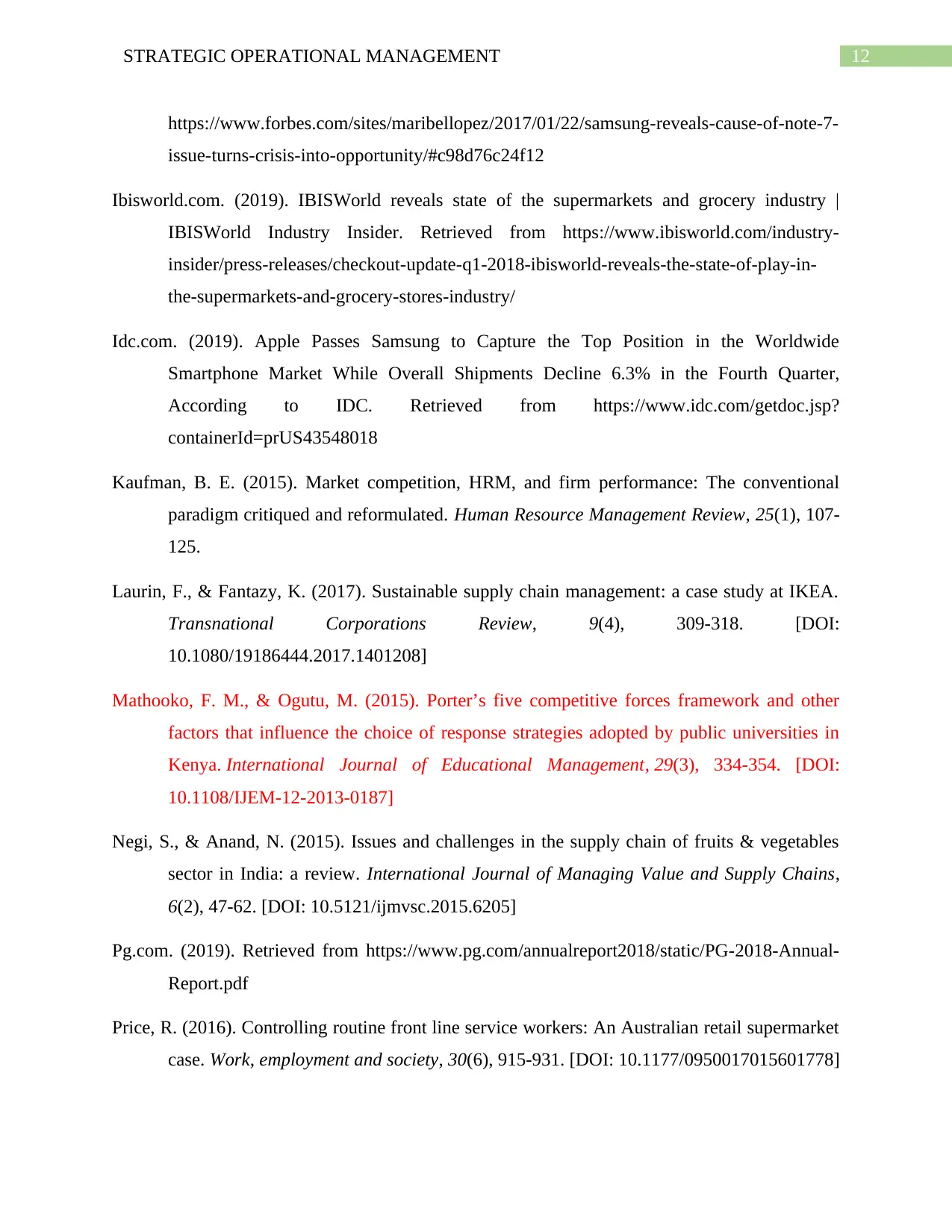
12STRATEGIC OPERATIONAL MANAGEMENT
https://www.forbes.com/sites/maribellopez/2017/01/22/samsung-reveals-cause-of-note-7-
issue-turns-crisis-into-opportunity/#c98d76c24f12
Ibisworld.com. (2019). IBISWorld reveals state of the supermarkets and grocery industry |
IBISWorld Industry Insider. Retrieved from https://www.ibisworld.com/industry-
insider/press-releases/checkout-update-q1-2018-ibisworld-reveals-the-state-of-play-in-
the-supermarkets-and-grocery-stores-industry/
Idc.com. (2019). Apple Passes Samsung to Capture the Top Position in the Worldwide
Smartphone Market While Overall Shipments Decline 6.3% in the Fourth Quarter,
According to IDC. Retrieved from https://www.idc.com/getdoc.jsp?
containerId=prUS43548018
Kaufman, B. E. (2015). Market competition, HRM, and firm performance: The conventional
paradigm critiqued and reformulated. Human Resource Management Review, 25(1), 107-
125.
Laurin, F., & Fantazy, K. (2017). Sustainable supply chain management: a case study at IKEA.
Transnational Corporations Review, 9(4), 309-318. [DOI:
10.1080/19186444.2017.1401208]
Mathooko, F. M., & Ogutu, M. (2015). Porter’s five competitive forces framework and other
factors that influence the choice of response strategies adopted by public universities in
Kenya. International Journal of Educational Management, 29(3), 334-354. [DOI:
10.1108/IJEM-12-2013-0187]
Negi, S., & Anand, N. (2015). Issues and challenges in the supply chain of fruits & vegetables
sector in India: a review. International Journal of Managing Value and Supply Chains,
6(2), 47-62. [DOI: 10.5121/ijmvsc.2015.6205]
Pg.com. (2019). Retrieved from https://www.pg.com/annualreport2018/static/PG-2018-Annual-
Report.pdf
Price, R. (2016). Controlling routine front line service workers: An Australian retail supermarket
case. Work, employment and society, 30(6), 915-931. [DOI: 10.1177/0950017015601778]
https://www.forbes.com/sites/maribellopez/2017/01/22/samsung-reveals-cause-of-note-7-
issue-turns-crisis-into-opportunity/#c98d76c24f12
Ibisworld.com. (2019). IBISWorld reveals state of the supermarkets and grocery industry |
IBISWorld Industry Insider. Retrieved from https://www.ibisworld.com/industry-
insider/press-releases/checkout-update-q1-2018-ibisworld-reveals-the-state-of-play-in-
the-supermarkets-and-grocery-stores-industry/
Idc.com. (2019). Apple Passes Samsung to Capture the Top Position in the Worldwide
Smartphone Market While Overall Shipments Decline 6.3% in the Fourth Quarter,
According to IDC. Retrieved from https://www.idc.com/getdoc.jsp?
containerId=prUS43548018
Kaufman, B. E. (2015). Market competition, HRM, and firm performance: The conventional
paradigm critiqued and reformulated. Human Resource Management Review, 25(1), 107-
125.
Laurin, F., & Fantazy, K. (2017). Sustainable supply chain management: a case study at IKEA.
Transnational Corporations Review, 9(4), 309-318. [DOI:
10.1080/19186444.2017.1401208]
Mathooko, F. M., & Ogutu, M. (2015). Porter’s five competitive forces framework and other
factors that influence the choice of response strategies adopted by public universities in
Kenya. International Journal of Educational Management, 29(3), 334-354. [DOI:
10.1108/IJEM-12-2013-0187]
Negi, S., & Anand, N. (2015). Issues and challenges in the supply chain of fruits & vegetables
sector in India: a review. International Journal of Managing Value and Supply Chains,
6(2), 47-62. [DOI: 10.5121/ijmvsc.2015.6205]
Pg.com. (2019). Retrieved from https://www.pg.com/annualreport2018/static/PG-2018-Annual-
Report.pdf
Price, R. (2016). Controlling routine front line service workers: An Australian retail supermarket
case. Work, employment and society, 30(6), 915-931. [DOI: 10.1177/0950017015601778]
Paraphrase This Document
Need a fresh take? Get an instant paraphrase of this document with our AI Paraphraser
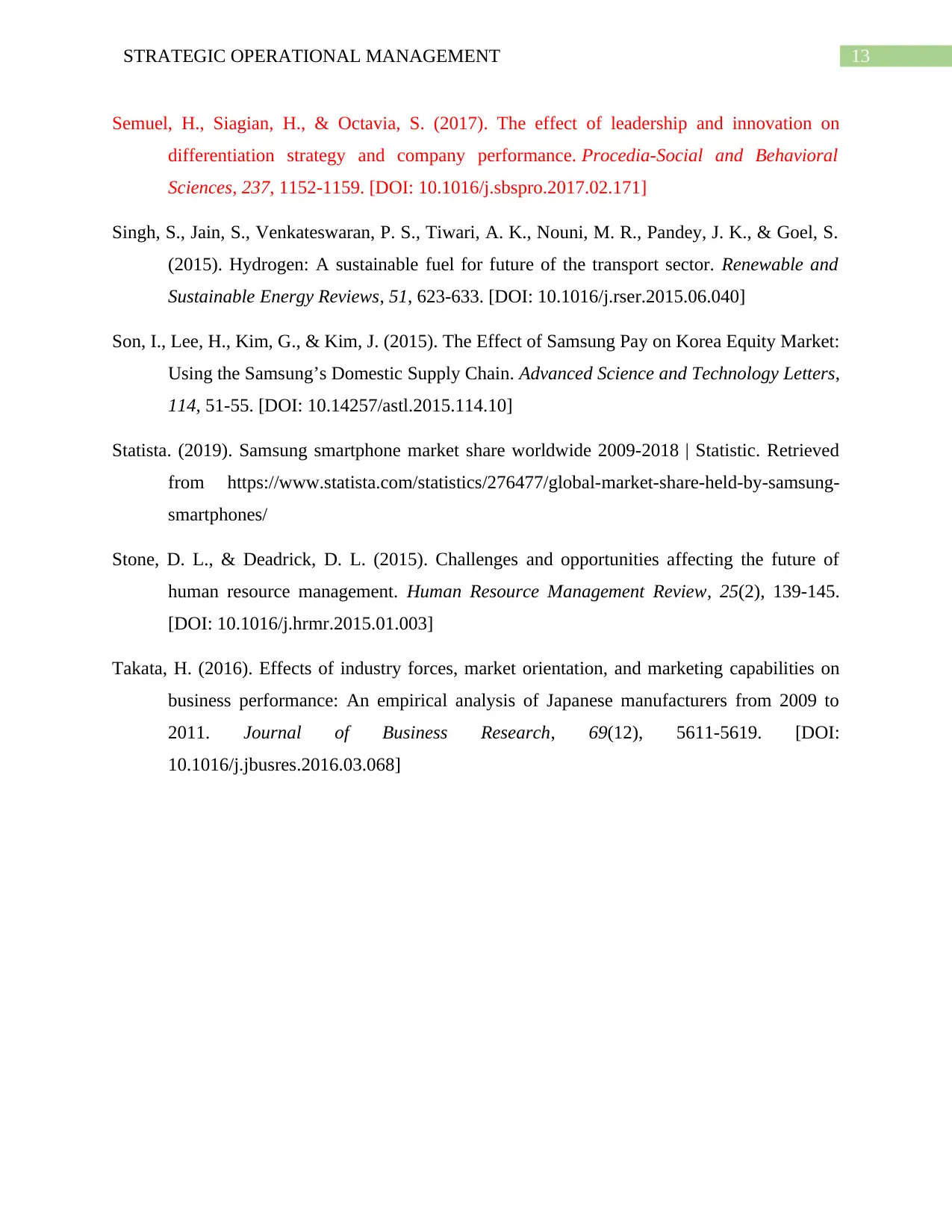
13STRATEGIC OPERATIONAL MANAGEMENT
Semuel, H., Siagian, H., & Octavia, S. (2017). The effect of leadership and innovation on
differentiation strategy and company performance. Procedia-Social and Behavioral
Sciences, 237, 1152-1159. [DOI: 10.1016/j.sbspro.2017.02.171]
Singh, S., Jain, S., Venkateswaran, P. S., Tiwari, A. K., Nouni, M. R., Pandey, J. K., & Goel, S.
(2015). Hydrogen: A sustainable fuel for future of the transport sector. Renewable and
Sustainable Energy Reviews, 51, 623-633. [DOI: 10.1016/j.rser.2015.06.040]
Son, I., Lee, H., Kim, G., & Kim, J. (2015). The Effect of Samsung Pay on Korea Equity Market:
Using the Samsung’s Domestic Supply Chain. Advanced Science and Technology Letters,
114, 51-55. [DOI: 10.14257/astl.2015.114.10]
Statista. (2019). Samsung smartphone market share worldwide 2009-2018 | Statistic. Retrieved
from https://www.statista.com/statistics/276477/global-market-share-held-by-samsung-
smartphones/
Stone, D. L., & Deadrick, D. L. (2015). Challenges and opportunities affecting the future of
human resource management. Human Resource Management Review, 25(2), 139-145.
[DOI: 10.1016/j.hrmr.2015.01.003]
Takata, H. (2016). Effects of industry forces, market orientation, and marketing capabilities on
business performance: An empirical analysis of Japanese manufacturers from 2009 to
2011. Journal of Business Research, 69(12), 5611-5619. [DOI:
10.1016/j.jbusres.2016.03.068]
Semuel, H., Siagian, H., & Octavia, S. (2017). The effect of leadership and innovation on
differentiation strategy and company performance. Procedia-Social and Behavioral
Sciences, 237, 1152-1159. [DOI: 10.1016/j.sbspro.2017.02.171]
Singh, S., Jain, S., Venkateswaran, P. S., Tiwari, A. K., Nouni, M. R., Pandey, J. K., & Goel, S.
(2015). Hydrogen: A sustainable fuel for future of the transport sector. Renewable and
Sustainable Energy Reviews, 51, 623-633. [DOI: 10.1016/j.rser.2015.06.040]
Son, I., Lee, H., Kim, G., & Kim, J. (2015). The Effect of Samsung Pay on Korea Equity Market:
Using the Samsung’s Domestic Supply Chain. Advanced Science and Technology Letters,
114, 51-55. [DOI: 10.14257/astl.2015.114.10]
Statista. (2019). Samsung smartphone market share worldwide 2009-2018 | Statistic. Retrieved
from https://www.statista.com/statistics/276477/global-market-share-held-by-samsung-
smartphones/
Stone, D. L., & Deadrick, D. L. (2015). Challenges and opportunities affecting the future of
human resource management. Human Resource Management Review, 25(2), 139-145.
[DOI: 10.1016/j.hrmr.2015.01.003]
Takata, H. (2016). Effects of industry forces, market orientation, and marketing capabilities on
business performance: An empirical analysis of Japanese manufacturers from 2009 to
2011. Journal of Business Research, 69(12), 5611-5619. [DOI:
10.1016/j.jbusres.2016.03.068]
1 out of 14
Related Documents
Your All-in-One AI-Powered Toolkit for Academic Success.
+13062052269
info@desklib.com
Available 24*7 on WhatsApp / Email
![[object Object]](/_next/static/media/star-bottom.7253800d.svg)
Unlock your academic potential
© 2024 | Zucol Services PVT LTD | All rights reserved.




